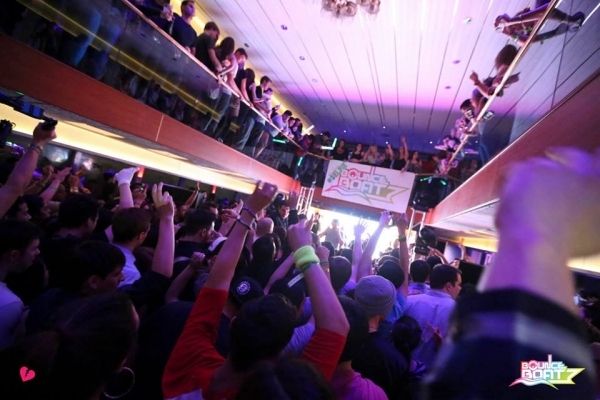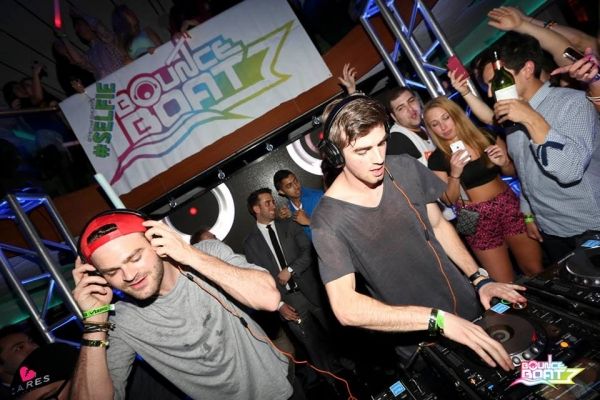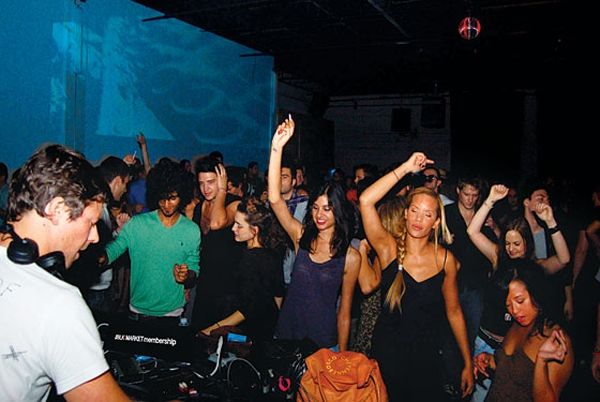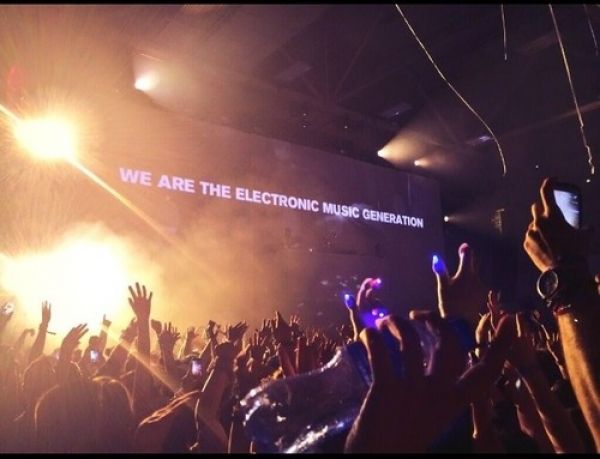

If you’re anything like us, you live and breathe electronic music. You listen to it all day long and love discovering new artists and subgenre styles. You’ve made friends through attending events and talking about it online, and feel like part of a larger, dance music community – a “scene”. Or maybe you’re a newer fan, just realizing that this awesome vibe is out there, and you want to be a part of it. Welcome.
In fact, with dance music in the states becoming so big, from the corporate EDM empire acquisitions to pop radio airplay, there seems to be more new fans every day. And while it’s easy to roll your eyes at people from school or work who ask you “where the best ‘EDM music’ concerts are”, the fact of the matter is that “EDM” is having an explosive moment in American youth culture. Yeah, it’s been happening in Europe (Ed.: and many other places outside the U.S really) all this time. We know. But people in the US are finally realizing how exciting and FUN electronic dance music and its subsequent culture is. Why should anyone be snobby about that?
Sure, there are some money-hungry motives behind many artists and those trying to capitalize on this “trend”. But the widespread nature of EDM is reaching so far, it’s not really a trend anymore, it simply is what is happening in music today. And that’s good. Why? Let me explain.
PARTY VIBES THAT EVERYONE CAN ENJOY

This past weekend, I had the privilege of representing EDMTunes while attending New York City’s first Bounce Boat voyage of the season, with the Chainsmokers headlining. The huge party yacht set sail from the West Side piers on an unfortunately grey, rainy Friday, but it didn’t matter to people who were already gearing to go at 6:30 pm, decked out in either rave attire or sleek, voguish fashions.
In fact, the dichotomy of the two styles made it painstakingly obvious who would be raging out, trading kandi and giving VapoRub massages downstairs, and who would be groovin’ and sipping on Belvedere from a bottle with strobe lights upstairs on the VIP mezzanine. By the end of the evening, the distinction between raving regulars and VIP fashionistas faded away, and for the most part, everyone was doing what they came there to do: DANCE and HAVE FUN. All in all, the combination of music and atmosphere made the Bounce Boat a perfect party. Yes, a party. Not a club night. Not a show. A party, for anyone.

The Chainsmokers delivered a set that perfectly accompanied this vibe, and introduced their viral hit “#SELFIE” it on the decks by saying “this song changed our lives”. Indeed it did – the duo has seen instantaneous, massive success thanks to the ultra-sharable track, and they did it themselves. They’re not sell-outs or mainstream for going from unknowns to headliners – their music is part of a new niche of catchy, party-ready electronic tracks that people outside the intense EDM fandom can recognize and dance along to, as everyone did during their set.
Maybe someone who got dragged along by their friends and never “got” electronic dance music felt the collective energy experienced on the dance floor that night, and went home and decided to check out some new artists. Maybe someone who has been doing the big-room house thing for a while realized they were had felt “the drop” too many times and were ready for more refined styles of electronica, like trance or even deeper house.
The point is, big-room house and viral EDM-infused hits a la The Chainsmokers are having moments in youth social consciousness because they are perfect introductions of electronic listening to virgin ears. The build-up-and-drop formatting helps newcomers or those who are only consumers of pop music follow along with the progressions and dance accordingly. And if they’re having a good time, so what if a set is chock-full of Beatport Top 20? If you don’t like it, don’t dance to it and go somewhere else, and leave more room for those enjoying it.
GREATER FEELINGS OF SUBCULTURAL SOLIDARITY
The EDM movement can hardly still be considered a subculture. Yet, the idea of being a “raver” and participating in electronic dance music expositions, whether they’re in basement clubs or festivals with tens of thousands of people, still has subcultural connotations. There is collective identity assumed by those sharing the rave experience. And one thing that fosters this identification, at least in the US, is fashion.
Think of your first proper rave, and what you saw people wearing. The plastic, beaded bracelets? What’s the deal with that? The stuffed animal backpacks? Cute, but I don’t get it. The tutus, fluffy legwarmers, and masks? Now this is just over the top.
But as you eventually discovered the beats and the beautiful people at the show and became a part of that collective energy, your perceptions changed. What about that moment someone taught you about the Peace, Love, Unity, and Respect handshake, and traded you your first piece of homemade kandi? Even more eye-opening than that initial observation of the rave life, I’m sure. And even if you think kandi is stupid, you have to admit the peace and love mantra behind it is pretty neat.
However, the fact that one can’t really wear light-up tshirts or fluffies to their 9-to-5 makes the fashion associated with the music also associated with specific events, at specific times and places. It’s not apparent in everyday life to most onlookers. It’s only at festivals and shows. So it’s still a slightly hidden subculture, no matter how big it actually gets, and it brings people together.
Remember back in September when Miami security officials banned kandi and other rave fashion symbols at Kaskade’s first stop on his Atmosphere tour? America’s favorite DJ spoke out against the imposition, blaming the authorities’ fear of the culture, which is too often times unfortunately associated with drug misuse. To them, those accessories symbolize lack of control of the crazy drug-fueled, bead-wearing zombies they view us as. “Taking away glow sticks, stuffed animals, + candy (*Kandi) makes them feel more in control,” Kaskade tweeted. “It’s still US vs. THEM”.
Even though thousands dress in this manner, and rave fashion is making its way into suburban mall stores, the outsider perspective still other-izes the participants. For example, recently, Cosmopolitan magazine, with an annual readership of nearly 14 million, ran a feature online on “Outrageous Music Festival Outfits” that scorned rave fashion and displayed complete carelessness on the matter. The caption for a picture of a beautiful, kandi-covered couple (below) reads “That headband (or one of her many bracelets/neon rubberbands) must be cutting off the circulation to her brain and affecting her judgement. Why else would she be kissing that guy?” Um, because they’re happy and they’re part of an amazing movement?

The way that our community called out the ignorant article (“rubberbands”? Are you serious?) and the Kaskade kandi ban illustrates a certain raver solidarity that exists despite what mass media magazines and fear-mongering authority officials have to say. And we did so by voicing our opinions and remaining true to the culture we love, in the spirit of PLUR, of course.
In conclusion, the people you know running out to Michael’s to buy beads and waving light-up gloves around with no gloving skills whatsoever aren’t as “bad for the scene” as you might think. People may be doing these things everywhere, but they still have a subcultural air about them, and with that comes understanding and solidarity.
UNDERGROUND RESPONSES AND AN IMAGE FOR OUR GENERATION

No one finds themselves part of an underground scene or listening to non-mainstream entities from the onset. They get there eventually as a response to the dominant culture they want to stray from. From intriguing several-hour “future house” sets, deep house warehouse parties, to Burning Man-inspired gatherings, it exists, if you search for that authenticity.
Underground dance stuff is definitely happening here (for many of us, it is not even underground, as many of these DJs and producers are mega stars…just not in the “American EDM” market), and it’s taking a lot of cues from Europe, of course. One can take a long look at nightlife and clubbing history in places like the UK and find that it’s always been a quintessential part of youth leisure there, from an early age onwards. How many fresh-out-of-high-school kids do you know in the states that are really into deep house or garage or techno? Not as many as there are overseas, I would bet.
In the US, you can’t even get into most clubs until you’re at least 21. Here, you have to be old enough and savvy enough to seek out the latest and greatest in electronica. (Do you know how much it hurt to not be allowed to see my favorite UK act, Dusky, at Output when I came back from studying abroad in London? A lot. It hurt a lot.) This age disparity has shaped the youth scene in America, and makes it easier for college-age kids to discover EDM bangers before they discover more progressive styles, and perhaps more mature, styles.
Regardless, alternative sounds are appealing to those bassheads who are done with “the drop”. As the massive dance tree grows, those who are truly interested will find budding branches to new venues, styles, and communities with which to express their love for the music. Just as punk rock was a response to the late 60’s, hippie-dippie guitar solo rock pushed by labels, and as grunge and alt-rock were responses to late 80’s/early 90’s one-hit-wonder bubblegum, so too is instrumental electronic dance music a response to electro-infused pop radio hits (a la the Black Eyed Peas) that have been shoved down our ears for years. Naturally, these offsets blew up on their own as well – hello, Nirvana – but ultimately, they stemmed from a subcultural response, were viewed as others/outsiders by the mainstream media, and ended up defining a generation. That’s what is happening with “EDM”. Get used to it.

The EDM phenomenon occurring RIGHT NOW will go down in the music history books, and you’re a part of it in some way. Whether you’d rather listen to Zedd than Katy Perry, or Eats Everything rather than Zedd, it doesn’t matter. You’re still a part of the scene, and you’re still making history. You’re not missing the point (and the PLUR) like those Cosmopolitan editors. You’re living it by being a part of a national, and ultimately, worldwide dance community. Embrace it, and don’t scorn those newer to it than you. As the one-and-only Above & Beyond put it, “We are the electronic music generation.” Try telling me that that statement is “bad for the scene”.


